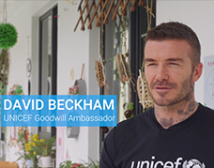NEW YORK/ BEIJING 20 November 2014 – Urgent action is needed to prevent millions of children from missing out on the benefits of innovation, UNICEF said in a new report launched on the 25th anniversary of the Convention on the Rights of the Child. Connectivity and collaboration can fuel new global networks to leverage innovation to reach every child, according to the children's agency.
The State of the World's Children Report – Reimagine the future: Innovation for every childcalls on governments, development professionals, businesses, activists and communities to work together to drive new ideas for tackling some of the most pressing problems facing children – and to find new ways of scaling up the best and most promising local innovations.
The report is a crowd-sourced compilation of cutting-edge innovations and an interactive platform that maps innovations in countries all over the world and invites innovators to put their own ideas ‘on the map'.
“Inequity is as old as humanity, but so is innovation – and it has always driven humanity's progress,” said UNICEF Executive Director Anthony Lake. “In our ever-more connected world, local solutions can have global impact – benefiting children in every country who still face inequity and injustice every day.
“For innovation to benefit every child, we have to be more innovative – rethinking the way we foster and fuel new ideas to solve our oldest problems,” said Lake. “The best solutions to our toughest challenges won't come exclusively either from the top down or the grassroots up, or from one group of nations to another. They will come from new problem solving networks and communities of innovation that cross borders and cross sectors to reach the hardest to reach – and they will come from young people, adolescents and children themselves.”
The United Nations General Assembly adopted the Convention on the Rights of the Child in 1989. Since then, there has been tremendous progress in advancing child rights – with a huge reduction in the numbers of children dying before the age of five and increased access to education and clean water.
However, the rights of millions of children are violated every day, with the poorest 20 percent of the world's children twice as likely as the richest 20 percent to die before their fifth birthday, almost one in four children in the least developed countries engaged in child labour, and millions of children regularly experiencing discrimination, physical and sexual violence, and abuse and neglect.
China has made tremendous progress in scientific and technological innovations that have contributed to improving the lives of children in China as well as around the world. Many leading academic institutions, entrepreneurs and intellectuals are developing new tools that can address disability, engage young people and improve access to public information on important health and development issues.
The latest edition of UNICEF's flagship report argues that innovations such as oral rehydration salts or ready-to-use therapeutic foods have helped drive radical change in the lives of millions of children in the last 25 years – and that more innovative products, processes, and partnerships are critical to realizing the rights of the hardest to reach children.
The fully digital report includes multimedia and interactive content that invites readers to share their own ideas and innovations, and highlights outstanding innovations that are already improving lives in countries around the world from a wide range of countries, including:
-
Solar Ear, the world's first rechargeable hearing aid battery charger, developed to meet the needs of communities lacking regular access to electricity; it can be charged via the sun, household light, or a cell phone plug. (Tendekayi Katsiga, Deaftronics, Botswana / Zimbabwe)
-
Community-based management of acute malnutrition (CMAM), a model of care that moves away from the traditional, expensive, low-coverage model of inpatient therapeutic feeding centres run by aid agencies, treats people in their homes with the support of local clinics and using ready-to-use therapeutic foods. (Steve Collins, co-Founder and Director of VALID Nutrition)
-
New ways to engage Liberian youth in the midst of the Ebola crisis through U-report, a mobile phone-based system developed with young people, that helps examine what issues are most important to them. (UNICEF, Liberia)
-
Floating schools that provide year-round access to education for children living in flood-prone regions of Bangladesh. (Mohammed Rezwan, Founding Executive Director of the NGO Shidhulai Swanirvar Sangstha)
-
Vibrasor, a device invented by two teenage girls in Colombia, to help people with hearing impairments navigate safely through busy urban areas. (Isamar Cartagena, Katherine Fernandez)
-
To find a new solution to help those without regular access to electricity in Nigeria, four teenage girls invented a urine-powered generator. (Nigeria)
“There are so many young inventors all cross the globe – even in the remotest corners – who are committed to changing the world for children,” says Bisman Deu, a 16-year old from Chandigarh, India whose invention of a building material made from rice waste is featured in UNICEF's report.
“Every nation has different problems and every person has different solutions,” said Deu. “We need to learn from one another's experiences, come together as a global community of innovation and keep producing ideas that can make a real difference.”
UNICEF has prioritized innovation across its network of more than 190 countries, setting up hubs around the world including in Afghanistan, Chile, Kosovo, Uganda, and Zambia to foster new ways of thinking, working and collaborating with partners and to nurture local talent.
Access the report at http://sowc2015.unicef.org
Share your ideas and innovations at http://sowc2015.unicef.org/your-innovations/
# # #
Access broadcast quality photos, b-roll and multimedia content on:
The State of the World's Children Report – Reimagine the future: Innovation for every child:http://uni.cf/1oNr5pM
The Convention on the Rights of the Child: http://uni.cf/1xtF8RY
About UNICEF: UNICEF promotes the rights and wellbeing of every child, in everything we do. Together with our partners, we work in 190 countries and territories to translate that commitment into practical action, focusing special effort on reaching the most vulnerable and excluded children, to the benefit of all children, everywhere. For more information about UNICEF and its work visit: www.unicef.org
About UNICEF Innovation: UNICEF Innovation is an interdisciplinary team of individuals around the world tasked with identifying, prototyping, and scaling technologies and practices that strengthen UNICEF's work to improve children's lives around the world. For more information visit:www.unicef.org/innovation
Follow us on Twitterand Facebookusing #EVERYchild
For further information, please contact:
Rose Foley, UNICEF Media, Tel: + 1 212 303 7987; Mobile: + 1 917 689 4316; E-mail:
rfoley@unicef.org
Melanie Sharpe, UNICEF Media, Tel: +1 917 265 4516; Mobile: + 1 917 485 3344; Email: msharpe@unicef.org




























